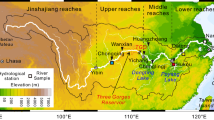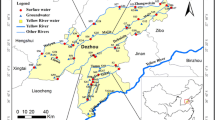Abstract
Isotopic compositions of the water sources and evapotranspiration in large rivers of China are not well explored. In this investigation, δ18O and δD values of water from major large rivers of China are integrated to understand the spatial and temporal variations in the isotopes of water and d-excess. River water samples were collected from the channels and tributaries of the Changjiang, Yellow, Songhua, and Liao Rivers in China. Water from upstream was generally enriched with light isotopes relative to that from downstream areas. Water from the Songhua River and upper reach of the Changjiang River has relatively negative isotopic values, impacted by latitude and altitude effects, respectively. The spatial pattern showed that δ18O-H2O values in rivers mainly ranged from −9 to −7 ‰ in most of China based on roughly mapped contours, and rivers enriched in light isotopes were primarily located in the Tibetan Plateau and northeast China. The slopes of linear regression from the Yellow and Liao Rivers suggested that the loss of water by direct evaporation shifted the isotopes of water, especially in some small tributaries. Additionally, there was a narrow range of low δ18O-H2O values from the main channel of rivers during the low-flow season relative to the high-flow season due to influence of the monsoon climate. No distinct spatial variation of d-excess values was found in the rivers of China. However, water samples in some rivers with low d-excess values had high δ18O values, indicating that evaporation in the tributaries has led to significant water loss, especially in tributaries of the Yellow and Liao Rivers.






Similar content being viewed by others
References
Bershaw J, Penny SM, Garzione CN (2012) Stable isotopes of modern water across the Himalaya and eastern Tibetan Plateau: implications for estimates of paleoelevation and paleoclimate. J Geophys Res. doi:10.1029/2011JD016132
Bowen GJ, Kennedy CD, Liu Z, Stalker J (2011) Water balance model for mean annual hydrogen and oxygen isotope distributions in surface waters of the contiguous United States. J Geophys Res 116:G04011. doi:10.1029/2010JG001581
Clark ID, Fritz P (1997) Environmental Isotopes in Hydrogeology. Lewis Publishers, New York
Craig H (1961) Isotopic variation in meteoric waters. Science 133:1702–1703
Criss RE (1999) Principles of stable isotope distribution. Oxford University Press, New York
Dalai TK, Bhattacharya SK, Krishnaswami S (2002) Stable isotopes in the source waters of the Yamuna and its tributaries: seasonal and altitudinal variations and relation to major cations. Hydrol Process 16:3345–3364
Dansgaard W (1964) Stable isotopes in precipitation. Tellus 16:436–468
Ding L, Xu Q, Zhang L, Yang D, Lai Q, Huang F, Shi R (2009) Regional variation of river water oxygen isotope and empirical elevation prediction models in Tibetan Plateau. Quat Sci 29:1–12 (in Chinese)
Ding T, Gao J, Shi G, Chen F, Luo X, Wang C, Hang D (2013) Spatial and temporal variations of H and O isotope compositions of the Yangtze River water and their environmental implications. Acta Geol Sinica 87:661–675 (in Chinese)
Gat JR (1996) Oxygen and hydrogen isotopes in the hydrologic cycle. Annu Rev Earth Planet Sci 24:225–262
Hren MT, Bookhagen B, Blisniuk PM, Booth AL, Chamberlain CP (2009) δ18O and δD of streamwaters across the Himalaya and Tibetan Plateau: implications for moisture sources and paleoelevation reconstructions. Earth Planet. Sci. Lett. 288:20–32
Huang Q, Qin X, Tang P, Liu P (2013) The characteristic and significance of carbon isotope(δ13CDIC) and oxygen isotope (δ18O) value in different type of karst water in Guilin. Geochimica 42:64–72 (in Chinese)
IAEA (2006) Global Network of Isotopes in Precipitation. The GNIP Database. http://isohis.iaea.org
Karim A, Veizer J (2002) Water balance of the Indus River Basin and moisture source in the Karakoram and western Himalayas: implications from hydrogen and oxygen isotopes in river water. J Geophys Res. doi:10.1029/2000JD000253
Kendall C, Coplen TB (2001) Distribution of oxygen-18 and deuterium in river waters across the United States. Hydrol Process 15:1363–1393
Lambs L, Balakrishna K, Brunet F, Probst JL (2005) Oxygen and Hydrogen isotopic composition of major Indian rivers: a first global assessment. Hydrol Process 19:3345–3355
Lambs L, Brunet F, Probst JL (2009) Isotopic characteristics of the Garonne River and its tributaries. Rapid Commun Mass Spectrom 23:2543–2550
Li SL, Liu CQ, Li J, Liu XL, Chetelat B, Wang BL, Wang FS (2010) Assessment of the sources of nitrate in the Changjiang River, China using a nitrogen and oxygen isotopic approach. Environ Sci Technol 44:1573–1578
Li SL, Liu CQ, Li J, Xue Z, Guan J, Lang Y, Ding H, Li LB (2013) Evaluation of nitrate source in surface water of southwestern China based on stable isotopes. Environ Earth Sci 68:219–228
Liu Y, Jiang G, Jin M, Li X (2009) Features of environmental isotopes of hydrogen and oxygen of water and their indication in Yanqi Basin, China. Geol Sci Technol Inf 28:89–93 (in Chinese)
Lu B, Sun T, Wang C, Dai S, Kuang J, Wang J (2012) Temporal and spatial variations of δ18O along the main stem of Yangtze River, China. In: IAEA (eds) Monitoring isotopes in rivers: creation of the Global Network of Isotopes in Rivers (GNIR). Vienna, pp 211–220
Luo W, Wang S, Liu X (2008) Regional characteristics of modern precipitation δ18O values and implications for paleoclimate research in China. Earth Environ 36:47–55 (in Chinese)
Michener R, Lajtha K (2007) Stable isotopes in ecology and environmental science, 2nd edn. Blackwell Publishing Ltd, Oxford
Nguyen KC, Huynh L, Le DC, Nguyen VN, Tran BL (2012) Isotope composition of Mekong River flow water in south of Vietnam. In: IAEA (eds) Monitoring isotopes in rivers: creation of the Global Network of Isotopes in Rivers(GNIR). Vienna, pp 197–210
Numaguti A (1999) Origin and recycling processes of precipitating water over the Eurasian continent: experiments using an atmospheric general circulation model. J Geophys Res 104:1957–1972
Rozanski K, Araguas-Araguas L, Gonfiantini R (1993) Isotope patterns in modern global precipitation. In: Swart PK et al (eds) Climate change in continental isotope records, geophysical monograph series, vol 78. AGU, Washington, pp 1–36
Su X, Lin X, Liao Z, Wang J (2003) Variation of isotopes in the Yellow River along the flow path and its affecting factors. Goechimica 32:349–357 (in Chinese)
Tian L, Masson-Delmotte V, Stievenard M, Yao T, Jouzel J (2001) Tibetan Plateau summer monsoon northward extent revealed by measurements of water stable isotopes. J Geophys Res 106:28,081–28088
Tian L, Yao T, MacClune K, White JWC, Schilla A, Vaughn B, Vachon R, Ichiyanagi K (2007) Stable isotopic variations in west China: a consideration of moisture sources. J Geophys Res 112:D10112. doi:10.1029/2006JD007718
Wassenaar LI, Athanasopoulos P, Hendry MJ (2011) Isotope hydrology of precipitation, surface and ground waters in the Okanagan Valley, British Columbia, Canada. J Hydrol 411:37–48
Wen R, Tian L, Weng Y, Liu Z, Zhao Z (2012) The altitude effect of δ18O in precipitation and river water in the Southern Himalayas. Chin Sci Bull 57:1693–1698
Yang X, Xu B, Yang W, Qu D, Lin P (2009) Study of altitudinal lapse rates of δ18O in precipitation/river water with seasons on the southeast Tibetan Plateau. Chin Sci Bull 54:2742–2750
Yao T, Zhou H, Yang X (2009) Indian monsoon influences altitude effect of δ18O in precipitation/river water on the Tibetan Plateau. Chin Sci Bull 54:2724–2731
Yu T, Gan Y, Zhou A, Liu C, Liu Y, Li X, Cai H (2010) Characteristics of oxygen and hydrogen isotope distribution of surface runoff in the Lhasa River Basin. J China Univ Geosci 35:873–878 (in Chinese)
Yue F-J, Li S-L, Liu C-Q, Zhao Z-Q, Hu J (2013) Using dual isotopes to evaluate sources and transformation of nitrogen in the Liao River, northeast China. Appl Geochem 36:1–9
Yue F-J, Liu C-Q, Li S-L, Zhao Z-Q, Liu X-L, Ding H, Liu B-J, Zhong J (2014) Analysis of δ15N and δ18O to identify nitrate sources and transformations in Songhua River, Northeast China. J Hydrol 519:329–339
Zhai Y, Wang J, Teng Y, Zuo R (2011) Variations of δD and δ18O in water in Beijing and their implications for the local water cycle. Resour Sci 33:92–97 (in Chinese)
Zhang X, Yao T (1998) Distributional features of δ18O in precipitation in China. Acta Geograph Sin 53:356–364 (in Chinese)
Zhang X, Yao T, Tian L, Liu J (2003) Stable oxygen isotope in water mediums in Urumqi River basin. Adv Water Sci 14:50–56 (in Chinese)
Zhang B, Guo Z, Gao A, Yuan X, Li K, Ma Z (2012) Estimating groundwater discharge into Minjiang River estuary based on stable isotopes deuterium and oxygen-18. Adv Water Sci 23:539–548 (in Chinese)
Zhao L, Yin L, Xiao H, Cheng G, Zhou M, Yang Y, Li C, Zhou J (2011) Isotopic evidence for the moisture origin and composition of surface runoff in the headwaters of the Heihe River basin. Chin Sci Bull 56:406–416
Zhao L, Xiao H, Zhou M, Cheng G, Wang L, Yin L, Ren J (2012) Factors controlling spatial and seasonal distributions of precipitation δ18O in China. Hydrol Process 26:143–152
Zhu DQ (2007) Dictionary of the Chinese River. Qingdao Press, Qingdao (In Chinese)
Acknowledgments
We thank Drs. Zhang Z, Deng Y, Liu B, Hu J, and Li J for their help during sample collection. This study is financially supported by National Natural Science Foundation of China (Grant Nos. 41210004 and 41130536) and Chinese Academy of Sciences through grants KZCX2-EW-102.
Author information
Authors and Affiliations
Corresponding author
Rights and permissions
About this article
Cite this article
Li, SL., Yue, FJ., Liu, CQ. et al. The O and H isotope characteristics of water from major rivers in China. Chin. J. Geochem. 34, 28–37 (2015). https://doi.org/10.1007/s11631-014-0015-5
Received:
Revised:
Accepted:
Published:
Issue Date:
DOI: https://doi.org/10.1007/s11631-014-0015-5




